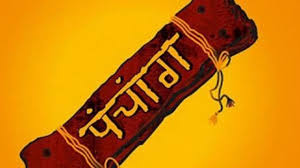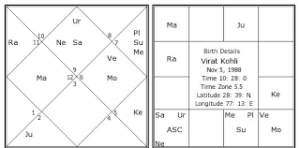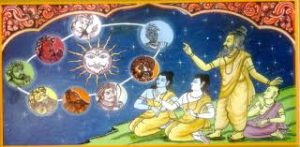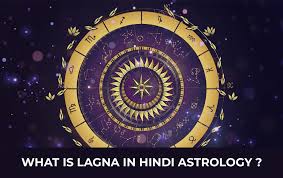Vedic Panchang (वैदिक पंचांग) is the traditional Hindu astrological calendar used to determine auspicious timings, planetary positions, and celestial influences on human life. It is based on Vedic astrology and consists of five key elements:
1️⃣ Tithi (तिथि) – Lunar day
2️⃣ Vaar (वार) – Day of the week
3️⃣ Nakshatra (नक्षत्र) – Star constellation
4️⃣ Yoga (योग) – Astronomical union of Sun & Moon
5️⃣ Karana (करण) – Half of a lunar day
How Vedic Panchang is Calculated
- Tithi Calculation: Based on the angular distance between the Sun and Moon.
- Nakshatra Calculation: The Moon moves through 27 Nakshatras, each spanning 13°20′ in the zodiac.
- Yoga Calculation: Determined by adding the longitudes of the Sun and Moon.
- Karana Calculation: Each Tithi has two Karanas, used for muhurta selection.
- Vaar (Weekday): Follows the solar cycle, each ruled by a planetary deity.
Importance of Vedic Panchang
- Used for muhurta selection (auspicious timings).
- Determines festival dates, vrats, and ritual timings.
- Helps in predicting planetary influences on human life.
1️⃣ Tithi (तिथि) – Lunar day
Tithi: Definition, Calculation & Types
Definition of Tithi
Tithi (तिथि) is the lunar day in Vedic astrology, determined by the angular distance between the Sun and Moon. Each Tithi represents a specific phase of the Moon and plays a crucial role in muhurta selection, rituals, and astrological predictions.
A lunar month consists of 30 Tithis, divided into Shukla Paksha (waxing phase) and Krishna Paksha (waning phase).
Tithi Calculation
- Tithi = (Longitude of Moon-Longitude of Sun) /12°
- A lunar month consists of 30 Tithis, divided into Shukla Paksha (waxing phase) and Krishna Paksha (waning phase).
- Each Tithi lasts approximately 0.9483 days but varies due to planetary motion.
- The duration of a Tithi can range from 21.5 to 26 hours, depending on the Moon’s speed.
Types of Tithis & Their Significance
1. Nanda Tithi (Happiness & Prosperity)
- Tithis: Pratipada (1st), Shashti (6th), Ekadashi (11th)
- Ruling Element: Fire
- Best for: Auspicious beginnings, spiritual activities, wealth accumulation
🔹 Example: Ekadashi is considered highly auspicious for fasting and spiritual growth.
2. Bhadra Tithi (Strength & Stability)
- Tithis: Dwitiya (2nd), Saptami (7th), Dwadashi (12th)
- Ruling Element: Earth
- Best for: Starting new ventures, laying foundations, career growth
🔹 Example: Saptami is ideal for initiating long-term projects or business investments.
3. Jaya Tithi (Victory & Success)
- Tithis: Tritiya (3rd), Ashtami (8th), Trayodashi (13th)
- Ruling Element: Ether
- Best for: Overcoming obstacles, competitive events, leadership roles
🔹 Example: Ashtami is associated with Goddess Durga and is powerful for overcoming challenges.
4. Rikta Tithi (Transformation & Removal)
- Tithis: Chaturthi (4th), Navami (9th), Chaturdashi (14th)
- Ruling Element: Water
- Best for: Removing negativity, destruction of obstacles, purification rituals
🔹 Example: Chaturthi is dedicated to Lord Ganesha and is ideal for removing hurdles in life.
5. Purna Tithi (Completion & Fulfillment)
- Tithis: Panchami (5th), Dashami (10th), Purnima (15th)
- Ruling Element: Air
- Best for: Celebrations, spiritual enlightenment, fulfillment of desires
🔹 Example: Purnima is considered highly auspicious for performing religious ceremonies and meditation.
Special Tithis & Their Importance
- Amavasya (New Moon) – Ideal for ancestral rituals and introspection.
- Purnima (Full Moon) – Best for spiritual practices and prosperity rituals.
- Ekadashi – Sacred for fasting and spiritual upliftment.
| Tithi | Type | Significance | Ideal Muhurtas & Life Examples |
|---|---|---|---|
| Pratipada (1st) | Nanda (Happiness) | Auspicious for new beginnings & financial growth | Housewarming, starting new business, marriage rituals |
| Dwitiya (2nd) | Bhadra (Strength) | Brings stability & success in endeavors | Land acquisition, buying a property, strengthening career decisions |
| Tritiya (3rd) | Jaya (Victory) | Overcoming obstacles, winning in competitions | Filing legal cases, competitive exams, new leadership roles |
| Chaturthi (4th) | Rikta (Removal) | Destruction of negative influences, purification | Ganesha Puja, overcoming hurdles, resolving disputes |
| Panchami (5th) | Purna (Completion) | Fulfillment of desires, spiritual growth | Upanayan Sanskar, spiritual learning, debt clearance |
| Shashti (6th) | Nanda (Happiness) | Brings prosperity, good health & wealth | Medical treatments, wellness & rejuvenation rituals |
| Saptami (7th) | Bhadra (Strength) | Strong foundations, growth-oriented decisions | Business expansion, important financial transactions |
| Ashtami (8th) | Jaya (Victory) | Associated with power, strength & overcoming fears | Durga Ashtami Puja, starting a career in defense, adventure sports |
| Navami (9th) | Rikta (Removal) | Destructive yet transformative energy | Releasing bad habits, quitting addictions, cutting off toxic influences |
| Dashami (10th) | Purna (Completion) | Brings success, fulfillment of goals | Government work, promotions, making impactful decisions |
| Ekadashi (11th) | Nanda (Happiness) | Spiritual upliftment, fasting & inner growth | Observing Ekadashi fast, meditation, mantra chanting |
| Dwadashi (12th) | Bhadra (Strength) | Enhances stability in finance & relationships | Property investment, strengthening relationships, charity work |
| Trayodashi (13th) | Jaya (Victory) | Overcoming karma, success-oriented activities | Debt repayment, achieving major career goals |
| Chaturdashi (14th) | Rikta (Removal) | Deep transformative energy, destruction of ego | Kali Puja, self-reflection, breaking bad cycles |
| Purnima (15th) | Purna (Completion) | Amplification of positive energy, prosperity | Marriage, housewarming, major celebrations |
| Amavasya (New Moon) | Rikta (Removal) | Ancestral rituals, introspection | Pitru Tarpan, meditation, resolving karmic influences |
Each Tithi plays a vital role in muhurta selection, ensuring astrological alignment for important life events.
2️⃣ Vaar (वार) – Day of the week
Significance of Vaar in Panchang
Vaar (वार) refers to the day of the week in the Hindu Panchang, and it plays a vital role in determining the auspiciousness of activities. Each Vaar is associated with a ruling planet, which influences the energy and characteristics of that day. The calculation of Vaar is based on the solar day, which begins at sunrise and ends at the next sunrise.
Significance of Each Vaar
| Vaar | Ruling Planet | Nature | Significance |
|---|---|---|---|
| Ravivar | Sun (Surya) | Dhruva (Fixed) | Ideal for leadership, government work, and starting new ventures. |
| Somvar | Moon (Chandra) | Char (Movable) | Best for emotional healing, travel, and nurturing activities. |
| Mangalvar | Mars (Mangal) | Ugra (Aggressive) | Suitable for tasks requiring courage, but avoid sensitive decisions. |
| Budhvar | Mercury (Budh) | Laghu (Light) | Excellent for communication, education, and intellectual pursuits. |
| Guruwar | Jupiter (Guru) | Kshipra (Quick) | Auspicious for spiritual growth, learning, and financial planning. |
| Shukravar | Venus (Shukra) | Mridu (Gentle) | Perfect for love, luxury, and artistic endeavors. |
| Shanivar | Saturn (Shani) | Tikshna (Sharp) | Good for discipline, hard work, and long-term planning. |
Calculation of Vaar
The calculation of Vaar is based on the Hora system:
- A day is divided into 24 Horas (hours), each ruled by a planet.
- The first Hora of the day determines the Vaar.
- For example, if the first Hora at sunrise is ruled by the Sun, the day is Ravivar (Sunday).
- The sequence of planetary rulers follows the order:
Sun → Moon → Mars → Mercury → Jupiter → Venus → Saturn.
Practical Applications
- Auspicious Activities: Certain Vaars are better suited for specific tasks (e.g., Guruwar for education, Shukravar for marriage).
- Planetary Influence: The ruling planet of the Vaar affects the energy of the day and the outcomes of activities.
- Muhurta Selection: Vaar is a key factor in determining the most favorable time for rituals and events.
Would you like a detailed analysis of a specific Vaar or its impact on astrological events? 🌟
Calculation of Vaar in Hora with Planetary Motions
Vaar (वार) refers to the day of the week, and its calculation is based on the Hora system. Hora divides the day into 24 planetary hours, each ruled by a specific planet. The sequence of planetary rulers is determined by their motion and speed in the solar system.
Hora Calculation Process
- Divide the Day into 24 Horas:
- A day begins at sunrise and ends at the next sunrise.
- The 24 Horas are split into 12 daytime Horas (sunrise to sunset) and 12 nighttime Horas (sunset to next sunrise).
- Determine the First Hora:
- The first Hora of the day is ruled by the planet associated with the Vaar (day).
- For example:
- Sunday (Ravivar) starts with the Sun’s Hora.
- Monday (Somvar) starts with the Moon’s Hora.
- Sequence of Hora Lords:
- The sequence follows the planetary motion order: Sun → Venus → Mercury → Moon → Saturn → Jupiter → Mars.
- This cycle repeats every 7 Horas.
- Planetary Motion Influence:
- The sequence is based on the speed of planets:
- Saturn (slowest) → Jupiter → Mars → Sun → Venus → Mercury → Moon (fastest).
- The sequence is based on the speed of planets:
Example of Hora Calculation
Let’s calculate the Horas for Monday (Somvar):
- Sunrise: 6:00 AM
- First Hora: Moon (Somvar’s ruling planet)
- Sequence of Horas:
- 6:00 AM – 7:00 AM: Moon
- 7:00 AM – 8:00 AM: Saturn
- 8:00 AM – 9:00 AM: Jupiter
- 9:00 AM – 10:00 AM: Mars
- 10:00 AM – 11:00 AM: Sun
- 11:00 AM – 12:00 PM: Venus
- 12:00 PM – 1:00 PM: Mercury
- The cycle repeats for the remaining hours.
Significance of Hora in Vaar
- Auspicious Timings: Certain Horas are favorable for specific activities (e.g., Jupiter’s Hora for spiritual growth, Venus’s Hora for love and luxury).
- Planetary Influence: The ruling planet of the Hora affects the energy and outcomes of activities performed during that time.
Practical Applications
- Sunday (Ravivar): Sun’s Hora is ideal for leadership and government work.
- Monday (Somvar): Moon’s Hora is best for emotional healing and nurturing.
- Tuesday (Mangalvar): Mars’s Hora is suitable for courage and energy-driven tasks.
- Wednesday (Budhvar): Mercury’s Hora is excellent for communication and intellectual pursuits.
- Thursday (Guruwar): Jupiter’s Hora is auspicious for wisdom and spirituality.
- Friday (Shukravar): Venus’s Hora is perfect for love and artistic endeavors.
- Saturday (Shanivar): Saturn’s Hora is good for discipline and long-term planning.
Here’s a detailed Hora chart for a complete 24-hour cycle, based on planetary rulership:
Hora Chart for Monday (Somvar)
| Time | Hora Lord | Planet Characteristics | Best Suitable Activities |
|---|---|---|---|
| 6:00 AM – 7:00 AM | Moon (Chandra) | Emotions, nurturing, intuition | Starting emotional healing or family-related tasks |
| 7:00 AM – 8:00 AM | Saturn (Shani) | Discipline, perseverance, focus | Planning long-term projects, introspection |
| 8:00 AM – 9:00 AM | Jupiter (Guru) | Wisdom, prosperity, spirituality | Education, financial planning, spiritual practices |
| 9:00 AM – 10:00 AM | Mars (Mangal) | Courage, aggression, energy | Competitive tasks, overcoming obstacles |
| 10:00 AM – 11:00 AM | Sun (Surya) | Authority, vitality, leadership | Career decisions, starting new ventures |
| 11:00 AM – 12:00 PM | Venus (Shukra) | Love, luxury, artistic creativity | Romantic pursuits, artistic endeavors, socializing |
| 12:00 PM – 1:00 PM | Mercury (Budh) | Intellect, communication, logic | Negotiations, writing, intellectual activities |
| 1:00 PM – 2:00 PM | Moon (Chandra) | Emotions, nurturing, intuition | Family bonding, emotional tasks |
| 2:00 PM – 3:00 PM | Saturn (Shani) | Discipline, perseverance, focus | Hard work, long-term planning |
| 3:00 PM – 4:00 PM | Jupiter (Guru) | Wisdom, prosperity, spirituality | Learning, charity, spiritual practices |
| 4:00 PM – 5:00 PM | Mars (Mangal) | Courage, aggression, energy | Physical activities, overcoming challenges |
| 5:00 PM – 6:00 PM | Sun (Surya) | Authority, vitality, leadership | Leadership roles, decision-making |
| 6:00 PM – 7:00 PM | Venus (Shukra) | Love, luxury, artistic creativity | Socializing, romantic activities |
| 7:00 PM – 8:00 PM | Mercury (Budh) | Intellect, communication, logic | Intellectual tasks, networking |
| 8:00 PM – 9:00 PM | Moon (Chandra) | Emotions, nurturing, intuition | Meditation, emotional healing |
| 9:00 PM – 10:00 PM | Saturn (Shani) | Discipline, perseverance, focus | Reflective tasks, planning |
| 10:00 PM – 11:00 PM | Jupiter (Guru) | Wisdom, prosperity, spirituality | Spiritual growth, learning |
| 11:00 PM – 12:00 AM | Mars (Mangal) | Courage, aggression, energy | Nighttime physical tasks, overcoming fears |
| 12:00 AM – 1:00 AM | Sun (Surya) | Authority, vitality, leadership | Planning for the next day, leadership tasks |
| 1:00 AM – 2:00 AM | Venus (Shukra) | Love, luxury, artistic creativity | Relaxation, creative pursuits |
| 2:00 AM – 3:00 AM | Mercury (Budh) | Intellect, communication, logic | Writing, intellectual tasks |
| 3:00 AM – 4:00 AM | Moon (Chandra) | Emotions, nurturing, intuition | Introspection, emotional healing |
| 4:00 AM – 5:00 AM | Saturn (Shani) | Discipline, perseverance, focus | Early morning planning, hard work |
| 5:00 AM – 6:00 AM | Jupiter (Guru) | Wisdom, prosperity, spirituality | Spiritual practices, learning |
3️⃣ Nakshatra (नक्षत्र) – Star constellation
In Panchang, Nakshatra (नक्षत्र) refers to the lunar constellations or star clusters that the Moon passes through during its journey around the Earth. The zodiac is divided into 27 Nakshatras, each spanning 13°20′ of the celestial sphere. These Nakshatras are a fundamental part of Vedic astrology and are used to determine auspicious timings, personality traits, and life events.
Key Features of Nakshatras
- Lunar Connection: The Moon spends approximately one day in each Nakshatra, completing all 27 in a lunar month.
- Padas (Quarters): Each Nakshatra is divided into 4 Padas (quarters), which further refine astrological predictions.
- Ruling Deities: Every Nakshatra is associated with a specific deity, influencing its characteristics and energy.
- Planetary Rulers: Each Nakshatra is governed by a planet, which impacts its effects on individuals.
Significance of Nakshatras in Panchang
- Janma Nakshatra: The Nakshatra in which the Moon is positioned at the time of birth is called the Janma Nakshatra. It plays a crucial role in determining personality, behavior, and destiny.
- Muhurta Selection: Nakshatras are used to identify auspicious timings for rituals, marriages, and other important events.
- Astrological Predictions: They help in analyzing planetary influences and predicting life events.
Here’s a detailed table of all 27 Nakshatras, their ruling deities, and key characteristics:
| Nakshatra | Deity | Key Characteristics |
|---|---|---|
| Ashwini | Ashwini Kumaras (Twin Gods) | Healing, speed, new beginnings |
| Bharani | Yama (God of Death) | Discipline, transformation, endurance |
| Krittika | Agni (God of Fire) | Energy, purification, determination |
| Rohini | Brahma (Creator) | Creativity, beauty, fertility |
| Mrigashira | Soma (Moon God) | Curiosity, exploration, gentleness |
| Ardra | Rudra (Storm God) | Destruction, renewal, emotional intensity |
| Punarvasu | Aditi (Mother of Gods) | Restoration, nurturing, optimism |
| Pushya | Brihaspati (Guru of Gods) | Nourishment, wisdom, spirituality |
| Ashlesha | Nagas (Serpent Gods) | Mystery, intuition, transformation |
| Magha | Pitris (Ancestors) | Heritage, leadership, authority |
| Purva Phalguni | Bhaga (God of Prosperity) | Luxury, relationships, creativity |
| Uttara Phalguni | Aryaman (God of Contracts) | Partnerships, agreements, stability |
| Hasta | Savitar (Sun God) | Dexterity, skill, resourcefulness |
| Chitra | Vishwakarma (Celestial Architect) | Creativity, craftsmanship, beauty |
| Swati | Vayu (Wind God) | Independence, adaptability, movement |
| Vishakha | Indra & Agni (Gods of Power) | Ambition, determination, duality |
| Anuradha | Mitra (God of Friendship) | Harmony, loyalty, cooperation |
| Jyeshtha | Indra (King of Gods) | Leadership, protection, responsibility |
| Mula | Nirriti (Goddess of Destruction) | Roots, transformation, endings |
| Purva Ashadha | Apah (Water Deity) | Invincibility, strength, renewal |
| Uttara Ashadha | Vishwadevas (Universal Gods) | Victory, truth, perseverance |
| Shravana | Vishnu (Preserver) | Listening, learning, preservation |
| Dhanishta | Vasus (Deities of Abundance) | Wealth, music, rhythm |
| Shatabhisha | Varuna (God of Cosmic Waters) | Healing, mystery, protection |
| Purva Bhadrapada | Aja Ekapada (One-Footed Goat) | Transformation, spirituality, sacrifice |
| Uttara Bhadrapada | Ahir Budhnya (Serpent of Depths) | Stability, wisdom, introspection |
| Revati | Pushan (Protector of Travelers) | Prosperity, guidance, nurturing |
Each Nakshatra has unique qualities influenced by its ruling deity, making them essential for astrological analysis and muhurta selection.
Example Ashwini Nakshatra
- Deity: Ashwini Kumaras (Twin Gods of Healing)
- Symbol: Horse’s Head
- Ruling Planet: Ketu
- Zodiac Sign: Aries (0° to 13°20′)
- Nature: Deva (Divine)
- Element: Fire
- Gana: Deva Gana (Godly Nature)
Ashwini Nakshatra is associated with speed, vitality, and healing. It represents the energy of new beginnings and is symbolized by a horse’s head, signifying swiftness and power. The Ashwini Kumaras, the celestial physicians, are its ruling deities, making this Nakshatra strongly connected to health and rejuvenation.
Characteristics of Ashwini Nakshatra Natives
- Positive Traits: Adventurous, energetic, quick learners, problem-solvers, and natural healers.
- Challenges: Impulsiveness, restlessness, and a tendency to act without foresight.
- Professions: Medicine, healing, transportation, athletics, and emergency services.
Ashwini Nakshatra Padas (Quarters)
- First Pada (0° to 3°20′ Aries): Ruled by Mars, natives are courageous and action-oriented.
- Second Pada (3°20′ to 6°40′ Aries): Ruled by Venus, natives are creative and beauty-loving.
- Third Pada (6°40′ to 10° Aries): Ruled by Mercury, natives excel in communication and networking.
- Fourth Pada (10° to 13°20′ Aries): Ruled by Moon, natives are nurturing and intuitive.
Example of Ashwini Nakshatra in Action
- Scenario: A person born under Ashwini Nakshatra may excel as a doctor or emergency responder due to their quick thinking and healing abilities. For instance, they might be the first to provide aid in a crisis, showcasing their swiftness and problem-solving skills.
- Muhurta Example: Ashwini Nakshatra is considered auspicious for starting new ventures, medical treatments, or travel-related activities. For example, a journey initiated during this Nakshatra is believed to be successful and smooth.
4️⃣ Yoga (योग) – Astronomical union of Sun & Moon
In Panchang, Yoga (योग) refers to the astronomical union of the Sun and Moon, calculated based on their combined longitudes. It is one of the five elements of Panchang, alongside Tithi, Vaar, Nakshatra, and Karana. Yoga is used to determine auspicious timings and the energetic influence of celestial bodies.
Calculation of Yoga
- Formula : (Longitude of the Sun + Longitude of Moon) / 13° 20′
- The sum of the Sun and Moon’s longitudes is divided into 27 equal parts, each spanning 13°20′.
- The resulting segment corresponds to one of the 27 Yogas.
Significance of Yoga
Each Yoga has unique characteristics and influences human life. For example:
- Siddhi Yoga: Associated with success and accomplishment.
- Vyatipata Yoga: Considered inauspicious, linked to calamities.
27 yogas
Here’s the updated list of the 27 Yogas with serial numbers for clarity:
| S.No. | Yoga | Meaning | Influence |
|---|---|---|---|
| 1 | Vishkumbha | Pot of Poison | Challenges, obstacles, and struggles; avoid important tasks. |
| 2 | Preeti | Happiness | Brings joy, harmony, and favorable outcomes. |
| 3 | Ayushman | Long Life | Promotes health, vitality, and longevity. |
| 4 | Saubhagya | Good Fortune | Enhances prosperity, success, and happiness. |
| 5 | Shobhana | Splendor | Brings beauty, charm, and auspiciousness. |
| 6 | Atiganda | Great Danger | Associated with difficulties, accidents, and challenges. |
| 7 | Sukarma | Good Deeds | Encourages virtuous actions, generosity, and success. |
| 8 | Dhriti | Steadiness | Promotes patience, stability, and perseverance. |
| 9 | Shoola | Spear | Indicates conflicts, arguments, and sharpness. |
| 10 | Ganda | Knot | Brings complexities, worries, and challenges. |
| 11 | Vriddhi | Growth | Encourages progress, prosperity, and expansion. |
| 12 | Dhruva | Fixed | Promotes stability, focus, and determination. |
| 13 | Vyaghata | Harm | Associated with violence, harm, and obstacles. |
| 14 | Harshana | Delight | Brings joy, laughter, and positive energy. |
| 15 | Vajra | Thunderbolt | Indicates strength, power, and sudden changes. |
| 16 | Siddhi | Accomplishment | Promotes success, achievements, and fulfillment. |
| 17 | Vyatipata | Calamity | Associated with misfortunes, disruptions, and challenges. |
| 18 | Variyan | Comfort | Brings luxury, relaxation, and indulgence. |
| 19 | Parigha | Obstruction | Indicates hindrances, delays, and challenges. |
| 20 | Shiva | Auspicious | Promotes peace, spirituality, and positive outcomes. |
| 21 | Siddha | Perfect | Encourages talent, skill, and success in endeavors. |
| 22 | Sadhya | Achievable | Promotes discipline, focus, and accomplishments. |
| 23 | Shubha | Auspicious | Brings good fortune, positivity, and success. |
| 24 | Shukla | Bright | Indicates clarity, purity, and positive energy. |
| 25 | Brahma | Creator | Promotes creativity, wisdom, and spiritual growth. |
| 26 | Indra | King of Gods | Brings leadership, authority, and success. |
| 27 | Vaidhriti | Division | Associated with separations, conflicts, and challenges. |
Example shubha yoga
Shubha Yoga is one of the 27 Yogas in the Panchang, known for bringing auspiciousness, success, and positive energy. The name itself means “fortunate” or “beneficial,” making it one of the most favorable Yogas for important life events.
This Yoga occurs when the combined longitudes of the Sun and Moon fall within a specific range, influencing the energy flow of the day. When active, Shubha Yoga enhances the prosperity and well-being of those undertaking major tasks.
Why is Shubha Yoga Important?
- Boosts Success – Great for starting new ventures, financial investments, and career growth.
- Enhances Positivity – Increases harmony in relationships and personal development.
- Fosters Spiritual Growth – Ideal for meditation, prayers, and religious rituals.
Best Activities During Shubha Yoga
- Marriage ceremonies 💍 (promotes a harmonious union)
- Business ventures 📈 (supports profitable outcomes)
- Housewarming (Griha Pravesh) 🏡 (creates lasting positivity)
- Spiritual practices 🕉️ (deepens wisdom and enlightenment)
5️⃣ Karana (करण) – Half of a lunar day
The calculation of Karana is based on the angular distance between the Sun and the Moon. Here’s how it works:
- Tithi Division: A Tithi is the time taken for the angular distance between the Sun and the Moon to increase by 12 degrees. Each Tithi is divided into two halves, and each half is called a Karana. F
- Formula : Karana = (Longitude of Moon -Longitude of Sun ) /6
- Angular Movement: A Karana lasts for approximately 6 degrees of the Moon’s movement relative to the Sun. For example, if the angular distance between the Sun and Moon is 0 degrees at the start of a lunar day, the first Karana ends when this distance reaches 6 degrees.
- Sequence: The first seven Karanas (Bava, Balava, Kaulava, Taitila, Garaja, Vanija, and Vishti) repeat eight times in a lunar month. The last four Karanas (Shakuni, Chatushpada, Naga, and Kimstughna) occur only once and are fixed.
Karana Table
| S.No. | Tithi | 1st Karana | 2nd Karana |
|---|---|---|---|
| 1 | Pratipada (1st) | Kimstughna | Bava |
| 2 | Dwitiya (2nd) | Balava | Kaulava |
| 3 | Tritiya (3rd) | Taitila | Garaja |
| 4 | Chaturthi (4th) | Vanija | Vishti (Bhadrā) |
| 5 | Panchami (5th) | Bava | Balava |
| 6 | Shashthi (6th) | Kaulava | Taitila |
| 7 | Saptami (7th) | Garaja | Vanija |
| 8 | Ashtami (8th) | Vishti (Bhadrā) | Bava |
| 9 | Navami (9th) | Balava | Kaulava |
| 10 | Dashami (10th) | Taitila | Garaja |
| 11 | Ekadashi (11th) | Vanija | Vishti (Bhadrā) |
| 12 | Dwadashi (12th) | Bava | Balava |
| 13 | Trayodashi (13th) | Kaulava | Taitila |
| 14 | Chaturdashi (14th) | Garaja | Vanija |
| 15 | Purnima (Full Moon) | Vishti (Bhadrā) | Bava |
| 16 | Amavasya (New Moon) | Balava | Kaulava |
| 17 | Pratipada (1st) | Taitila | Garaja |
| 18 | Dwitiya (2nd) | Vanija | Vishti (Bhadrā) |
| 19 | Tritiya (3rd) | Bava | Balava |
| 20 | Chaturthi (4th) | Kaulava | Taitila |
| 21 | Panchami (5th) | Garaja | Vanija |
| 22 | Shashthi (6th) | Vishti (Bhadrā) | Bava |
| 23 | Saptami (7th) | Balava | Kaulava |
| 24 | Ashtami (8th) | Taitila | Garaja |
| 25 | Navami (9th) | Vanija | Vishti (Bhadrā) |
| 26 | Dashami (10th) | Bava | Balava |
| 27 | Ekadashi (11th) | Kaulava | Taitila |
| 28 | Dwadashi (12th) | Garaja | Vanija |
| 29 | Chaturdashi (14th) | Vishti (Bhadrā) | Shakuni |
| 30 | Amavasya (New Moon) | Chatushpad | Naga |




